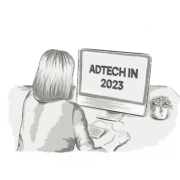2016 was a busy year for the Ad Tech & MarTech industries – there were acquisitions & mergers, new players entering the markets, and lots of innovation.
And here at Clearcode we wrote a lot about various topics in the Ad Tech & MarTech spaces in 2016.
So much so, we decide to compile a list of our most popular blog posts from last year.
Here are our top 16 (8 Ad Tech and 8 MarTech) articles that we published in 2016.
Clearcode’s Most Popular Ad Tech Posts Of 2016
1. Why You Need A Data Management Platform (DMP)
In an effort to increase marketing ROI, marketers, advertisers, and agencies have increased the number of the campaigns across many channels. The result is poor ROI caused by low engagement.
In order to solve this ever-growing problem, companies need to stop trying to reach more people and start trying the reach more of the right people, and a DMP helps them do just that.
2. What is First-Party Data Onboarding and How Does it Work?
In years past, there was a big focus on acquiring and integrating third-party data with a company’s first-party data. While the third-party data wasn’t as valuable as the first-party information, it enabled companies to identify customer behaviors and trends, and helped them get their message in front of more people.
However, marketers and advertisers are now finding that even with these improvements, the real payoff is found in first-party data, which, according to a recent study from Econsultancy and Signal, the use of for advertising is set to rise due to the value it brings to a company.
3. What is Header Bidding and How Does it Work?
Back in the early days of the Internet, when an advertiser wanted to buy ad space on a publisher’s website, they would call up the publisher’s sales team to make the purchase.
While the direct advertiser-publisher relationship is still around, the introduction and growth of technology has added speed, efficiency, and scale to the online media buying and selling process.
As the number of technology platforms has increased, so too has the number of processes; and one process gaining traction in the ad-tech world is header bidding.
4. The Benefits Of A First-Party Cookie Approach In Online Advertising
There is a lot of talk within the industry about the future of third-party cookies.
Some say they will always have a place in the online advertising ecosystem, while others argue they simply won’t be around in the coming years, either due to ad blockers or new technologies that will provide universal tracking across devices, therefore replacing the need for third-party cookies.
Regardless of your position on the issue, one thing is clear: For advertisers, marketers, and Ad Tech companies, there are a number of benefits to moving away from third-party cookies and adopting a first-party-cookie approach.
5. Advantages and Disadvantages of Programmatic Direct for Publishers
You may know it by many different names…”automated guaranteed,” “automated direct,” “automated reserved”…or “programmatic direct.”
Whatever people call it, the process of buying and selling digital media in a direct demand-supply side relationship accounts for a majority of programmatic ad spend.
And that’s despite real-time bidding getting a lot of the hype and attention.
6. Real-Time Bidding & Programmatic: One and the Same?
Advertising technology seems to have a language all its own. Pay-per-click, demand-side platform (DSP), ad exchange — the list goes on and on.
Out of all the jargon, there are two terms that have become real buzzwords in recent years, and understanding them is key to getting a handle on ad tech and, ultimately, reaping its benefits.
And these 2 terms are programmatic and real-time bidding (RTB).
While programmatic and real-time bidding are closely connected and often used together, the two words are not synonymous.
7. How Does Ad Blocking Work & What Can Publishers Do About It?
Ad blockers have made a lot of people really nervous. The group that’s really sweating is publishers – and rightly so.
Many fear that this sudden rise in the use of ad blocking software will severely hamper the online advertising industry and in many ways their fears seem justified.
But there are some things that publishers (and advertisers) can do to counter this trend.
8. AdTech Targeting Methods: The Ultimate Guide
Before marketers pull the trigger on a new campaign, they need to know which AdTech targeting methods to use.
Should they use behavioural targeting? Demographic targeting? How will we reach our most valuable audience?
The last thing a brand wants to do is fire off an expensive campaign aimed at the wrong people. So while advertising technology has given companies a multitude of tools to work with, one huge key is knowing how define your target audience and how to get your hands on the data you need to “aim” your campaign correctly.
Clearcode’s Most Popular MarTech Posts Of 2016
1. Game Theory Attribution: The Model You’ve Probably Never Heard Of
As an online marketer, how do you attribute conversions and assign credit to the different channels in your conversion paths?
Do you use the obsolete last-click attribution model? Or the equally flawed first-click attribution model?
Attribution is hard enough without using the over-simplistic attribution models that currently exist.
But imagine if instead of using an attribution model that unfairly gives credit to different channels in a customer’s journey you could use one that assigns credit based on actual influence?
Enter game theory attribution.
2. What Is Cross-Device Attribution And What’s So Hard About It?
One of the most common attribution models is the cross-channel model, which aims to identify which touch points a consumer had across different channels before they converted (e.g. purchased a product or downloaded an ebook). This type of attribution is relatively easy to achieve, provided you implement the right techniques.
However, attribution starts to get challenging when consumers start interacting with a brand across different channels and on different devices.
This is known as the cross-device customer journey.
3. Insider’s View: AdTech & MarTech Q&A With Scott Brinker [Part 7]
If there’s one “household” name on the marketing technology scene, it is Scott Brinker. The publication of his yearly Marketing Technology Landscape Supergraphic is a major event, as is the annual MarTech conference series he helps organize.
We caught up with Scott and asked him to share his insights into the dynamic world of MarTech, its current state and future prospects.
4. Innovation Drives MarTech Growth
Marketing, arguably more than any other business sector, has thrived on technical innovations since the dawn of the internet age, leading to the feverish expansion of the ecosystem that we have today.
Why is that?
One of MarTech’s most active venture capitalists, Neeraj Agrawal of Battery Ventures (whose portfolio includes Marketo, Optimizely, Tealium and Bazaarvoice to name a few) has an answer.
5. Getting a Grip on the MarTech Ecosystem
Never has the Marketing Technology (MarTech) ecosystem been so big or complex.
The numbers speak for themselves – over 1800 vendors scattered over 43 different categories. And growing.
It’s enough make any CMO’s head spin.
In such a vast landscape, it’s no wonder that marketers are often paralyzed by the frighteningly broad range of platforms and solutions to choose from when building a marketing stack.
6. Why Modern Marketers Need To Be More Tech Savvy
Technology has changed the way most people do their jobs. That includes marketers, too.
The digital age has drastically altered the speed, relevancy, and range of marketing campaigns. This has forced marketers everywhere to become more tech savvy as they concentrate their efforts on connecting with consumers in the vast world of the internet.
Analyzing and utilizing customer data through CRM platforms or creating content with Search Engine Optimization (SEO) in mind are just some of the examples of ways marketers use technology, but being tech savvy means more than just knowing how to use an application.
7. Marketing Automation: More Popular Than Ever?
John Wannamaker, the revolutionary 19th century New York merchant, is famously purported to have declared in desperation, “half the money I spend on advertising is wasted; the trouble is I don’t know which half.”
Today, money is still being wasted in advertising and marketing – and a good deal of time as well. And that amounts to about the same thing if you believe that time is money.
Their capacity for saving time – and by extension, money – in a variety of ways is the main factor that has propelled automation platforms to the top of many marketers’ wish list of technical solutions.
8. What Exactly is MarTech?
Marketing technology – more commonly known as MarTech – is one of the fastest growing areas in technology today. You may have heard of it, or even started to explore it.
But instead of just dabbling in it, you really ought to try to understand it in it’s entirety.








